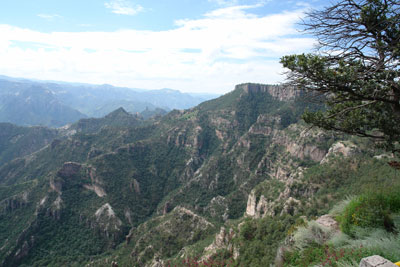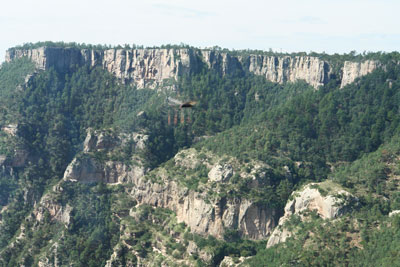Recollections: Copper Canyon — the other side of Mexico
This item appears on page 65 of the November 2009 issue.
by Deanna Palic
Now that ITN is following the readers’ vote to include Mexico in our publication, I think it appropriate to reminiscence. In December 1983 I escorted a tour group to Mexico’s Copper Canyon (for a company no longer in business). The itinerary covered the route from Los Mochis to the canyon and on to Chihuahua, where we celebrated New Year’s Eve.
I term the Copper Canyon region “the other side of Mexico” because it is not a succession of beach resorts nor sleepy cobblestone colonial towns. It is part of the rugged terrain of Mexico of which many travelers are not aware.
In order to ensure that my recollections are accurate, I called upon Ed Gill of Sanborn Tours. Ed travels the Copper Canyon frequently and agreed to review my notes.
Sanborn Tours, reportedly the first tour company to take travelers through the canyon, is one of ITN’s advertisers. Even though, editorially, ITN has not covered Mexico until now, Sanborn Tours has steadfastly advertised their Mexico trips in the magazine.
Mexico’s Pacific coast
Los Mochis, where we started our tour, is a city of 215,000 inhabitants located at the western terminus of the rail line to Copper Canyon; at the other end of the line is Chihuahua.
Our group stayed at Hotel Santa Anita (Av. G. Leyva & M. Hidalgo, Los Mochis, Sinaloa, México; phone 011 52 668 816 70 46, fax 011 52 668 812 0046, www.santa anitahotel.com), a pleasant 4-star property ideally located in the city center. Standard rates are $90 single and $80 double.
Although the food at the hotel was quite good, a small group of us strolled over for dinner at El Farallon (phone 011 52 668 812 1273, www.farallon.com.mx), at the intersection of Obregón and Angel Flores. I still haven’t forgotten the camarones rellenos de queso (shrimp stuffed with cheese and wrapped in bacon), currently priced at $10.
The star attraction
Located in the Sierra Tarahumara, Barrancas del Cobre, or the Copper Canyon, is a group of six distinct canyons in the southwestern part of the state of Chihuahua, located in northeastern Mexico.
The overall canyon system is, at the very least, seven times larger than, and portions are deeper than, the Grand Canyon in Arizona with which it often is compared.
The canyons were formed by six rivers, which drain the western side of the Sierra Tarahumara (a part of the Sierra Madre Occidental). All six merge into the Rio Fuerte and empty into the Sea of Cortez.
The walls of the canyon are a copper-green color, hence the name.
All aboard
The railway to the canyon was known as the Chihuahua-Pacific railroad until Union Pacific purchased the train a few years ago. Union Pacific replaced equipment and updated the cars and it is now known as Chihuahua al Pacifico “Chepe.”
The rail system is an astounding engineering feat, having taken 11 international corps of engineers over 100 years to build. The resulting cost was $100,000,000.
The system of tracks, which includes 37 bridges and 85 tunnels, affords breathtaking vistas at every turn. As El Chepe inches its way up into the heart of the Sierra Occidental, it makes a journey that train buffs dream about.
It was not until 1961 that tourist travel to the Copper Canyon became a reality. As the train climbs, notice what appear to be abandoned railroad cars. If you look closely, you will see that the ingenious locals have turned these into unique homes.
Divisadero, at 8,500 feet, is the highest point in the canyon. In December it was quite cold there, especially at night.
The primary claim to fame of Hotel Divisadero Barrancas (Mirador 4516, Residencial Campestre, Chihuahua, Chih., México 31238; phone 011 52 614 415 1199 or, for reservations, 888/232-4219, fax 011 52 614 415 6575, www.hoteldivisadero.com), perched dramatically right on the rim of the Copper Canyon at 7,500 feet, is its location.
The hotel is adjacent to the train station and is actually a collection of buildings strung out along the curving rim. Navigating between buildings necessitates using three ramps, walkways and stairs.
Overall, the hotel is definitely rustic, but it still provides all the essentials. Rates in summer, June-August, are $120 single and $180 double and in the remainder of the year, $185 single and $220 double. Rates include lodging, three meals daily, two guided walking tours and taxes.
At the end of the line, Chihuahua impressed me as an attractive, middle-class city. I enjoyed the visit to Francisco “Pancho” Villa’s home, which is now a museum.
Sanborn Tours (McAllen, TX; 800/395-8482, www.sanborns.com), now in its 60th year, offers a 9-day/8-night package which visits Torreón, Durango, Mazatlán, Culiacán, Los Mochis, Copper Canyon, Creel, Chihuahua and Saltillo. In 2010 the land-only price will be $998 per person, based on double occupancy.


